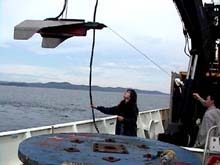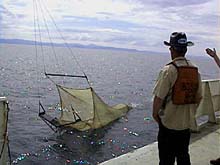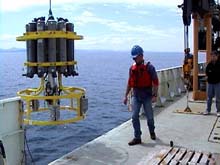
Jackie Popp-Noskov deploys the bioacoustic profiler during preliminary testing in the Strait of Juan de Fuca. Click image for larger view.

Mid-water trawls, like the one shown here, will be used in conjunction with bioacoustic profiling to study the fishes and invertebrates of Astoria Canyon. Click image for larger view.
The NOAA Ship Ronald H. Brown's chief bosun deploys a hydrocast with a CTD and an array of water sampling bottles during an equipment check in the Strait of Juan de Fuca. Click image for larger view.
Visiting the Frontier: Diving into the Astoria Canyon
(Phase 2 of the Expedition)
June 26, 2001
Jeff Goodrich, Teacher-at-sea
Earth Science Teacher
Lake Oswego High School
Lake Oswego Oregon
and
Susan Merle, Geological Research Assistant
CIMRS Program, Oregon State University
Vents Program, Pacific Marine Environmental Laboratory, NOAA
From June 22 through the morning of June 26, 33 scientists and 22 crew members prepared the NOAA Ship Ronald H. Brown for the Lewis and Clark Legacy voyage to Astoria Canyon. The ship departed Victoria, British Columbia, at 10 am Pacific time, and paused for several hours in the Strait of Juan de Fuca to test the multitude of scientific instruments that will be used to investigate the canyon. The researchers will use the Canadian-built remotely operated vehicle (ROV) ROPOS to examine the canyon floor and walls. Two weeks prior to this expedition, a sidescan sonar and bathymetry cruise to the canyon provided geological information that will be used to establish habitat boundaries for fish and invertebrates.
Sea-floor transects with ROPOS will explore the canyon's geology and biology. These transects will provide information on the population density for both fishes and invertebrates. Together, the biological and geological information gathered during the expedition will allow scientists to quantify population and habitat associations. Invertebrate specimens collected during the voyage will be permanently archived at the world-renowned Natural History Museum of Los Angeles County, California.
Investigations in the mid-water realm will include mooring deployments and bioacoustic profiling. The moorings have sensors for current flow, water temperature and optical backscattering (the amount of particles in the water). The bioacoustic profiler will be used to remotely observe the behavior, distribution, and biomass of zooplankton and fish.
The ship will arrive at Astoria Canyon on the morning of June 27 to commence an intensive exploration of this virtually unexplored ocean feature.
Sign up for the Ocean Explorer E-mail Update List.






























